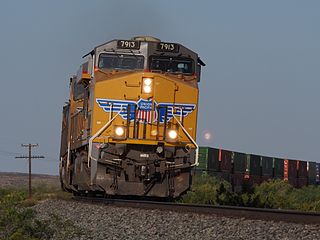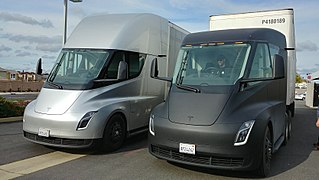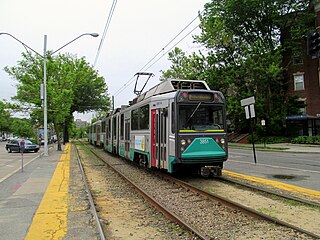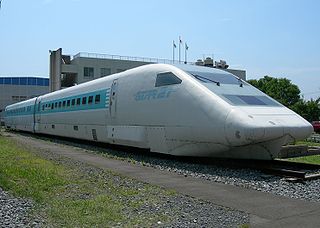See also
| This disambiguation page lists articles associated with the title Green Car. If an internal link led you here, you may wish to change the link to point directly to the intended article. |
Green Car may refer to:
| This disambiguation page lists articles associated with the title Green Car. If an internal link led you here, you may wish to change the link to point directly to the intended article. |

A train is a form of rail transport consisting of a series of connected vehicles that generally run along a railroad track to transport passengers or cargo. The word "train" comes from the Old French trahiner, derived from the Latin trahere meaning "to pull" or "to draw".

A hybrid vehicle uses two or more distinct types of power, such as submarines that use diesel when surfaced and batteries when submerged. Other means to store energy include pressurized fluid in hydraulic hybrids.
In transportation, platooning or flocking is a method for driving a group of vehicles together. It is meant to increase the capacity of roads via an automated highway system.

A hydrogen vehicle is a vehicle that uses hydrogen fuel for motive power. Hydrogen vehicles include hydrogen-fueled space rockets, as well as automobiles and other transportation vehicles. The power plants of such vehicles convert the chemical energy of hydrogen to mechanical energy either by burning hydrogen in an internal combustion engine, or, more commonly, by reacting hydrogen with oxygen in a fuel cell to power electric motors. Widespread use of hydrogen for fueling transportation is a key element of a proposed hydrogen economy.

An electric vehicle (EV), also called electrics is a vehicle that uses one or more electric motors or traction motors for propulsion. An electric vehicle may be powered through a collector system by electricity from off-vehicle sources, or may be self-contained with a battery, solar panels, fuel cells or an electric generator to convert fuel to electricity. EVs include, but are not limited to, road and rail vehicles, surface and underwater vessels, electric aircraft and electric spacecraft.
METRORail is the 22.7-mile (36.5 km) light rail system in Houston, Texas. As of 2015, the METRORail has an average weekday ridership of 56,600 and total annual ridership of 18.335 million. After Dallas's DART Light Rail, METRORail ranks as the second most-traveled light rail system in the Southern United States and the 12th most-traveled light rail system in the United States. METRORail is operated by the Metropolitan Transit Authority of Harris County (METRO).

The 0 series trains were the first generation Shinkansen trainsets built to run on Japan's new Tōkaidō Shinkansen high-speed line which opened in Japan in 1964. The last remaining trainsets were withdrawn in 2008.

The 700 series is a Japanese Shinkansen high-speed train type built between 1997 and 2006, and entering service in 1999. Originally designated as "N300" during the development phase, they formed the next generation of shinkansen vehicles jointly designed by JR Central and JR-West for use on the Tokaido Shinkansen, Hakata Minami Line and the San'yō Shinkansen. Though it has since been withdrawn from service on the Tōkaidō Shinkansen, it still operates on the San'yō Shinkansen and Hakata Minami Line.

The Green Line is a light rail system run by the Massachusetts Bay Transportation Authority (MBTA) in the Boston, Massachusetts, metropolitan area. It is the oldest Boston rapid transit line, and with tunnel sections dating from 1897, the oldest in America. It runs as a deep-level subway through downtown Boston, and on the surface into inner suburbs via four branches on several radial boulevards. With an average daily weekday ridership of 152,200 in 2019, it is the second most heavily used light rail system in the country. The line was assigned the green color in 1967 during a systemwide rebranding because several branches pass through sections of the Emerald Necklace of Boston.

The British Rail Class 501 electric multiple units were built in 1955/56 for use on the former LNWR/LMS suburban electric network of the London Midland Region. A total of 57 three-car units were built.
The Kinki Sharyo Co., Ltd., also known as Kinkisharyo, is a Japanese manufacturer of railroad vehicles based in Osaka. It is an affiliate company of Kintetsu Corporation. In business since 1920 and renamed The Kinki Sharyo Co., Ltd in 1945. They have produced light rail vehicles used by a number of transportation agencies. Kinki Sharyo is listed on the Tokyo Stock Exchange as TYO: 7122

In a railway accident, telescoping occurs when the underframe of one vehicle overrides that of another, and smashes through the second vehicle's body. The term is derived from the resulting appearance of the two vehicle bodies: the body of one vehicle may appear to be slid inside the other like the tubes of a collapsible telescope – the body sides, roof and underframe of the latter vehicle being forced apart from each other.

The McCarran International Airport People Movers are three separate automatic people mover systems operating at McCarran International Airport near Las Vegas, Nevada. The people mover system consists of three separate lines: the Green Line connecting the Main Terminal to the C Gate Concourse, the Blue Line connecting the Main Terminal to the D Gate Concourse, and the Red Line connecting the D Gates Concourse to Terminal 3.

The Siemens Modular Metro is a family of electric multiple unit trains for rapid transit systems produced by Siemens Transportation Systems and used by rail operators around the world. The vehicle concept was launched in Vienna in 2000 and is a modular concept allowing many variants of metro vehicles. Previously known as Modular Mobility, Siemens, whose rail equipment division has been renamed Siemens Mobility, still uses the abbreviation Mo.Mo; however, these trains are no longer being made, having been replaced by Siemens's new Inspiro family of metro trainsets.
The opening of the Metro Blue Line in 2004 marked the beginning of Metro Transit's expansion into rail transit, 50 years after the last Twin Cities Rapid Transit streetcars were taken out of service. Several new rail transit projects are either under construction or in planning stages and more are expected to be explored in the near future. Metro Transit will likely be acquiring a significant amount of rolling stock as these new projects move forward.

"STAR21" was the name given to the Class 952/953 (952・953形) 9-car experimental Shinkansen train developed in 1992 by the East Japan Railway Company in Japan to test technology to be incorporated in next-generation shinkansen trains operating at speeds of 350 km/h (217 mph) or higher. The name was an acronym for "Superior Train for the Advanced Railway toward the 21st Century".

The KiHa 281 series (キハ281系) is a tilting diesel multiple unit (DMU) train type operated by Hokkaido Railway Company on Super Hokuto limited express services in Hokkaido, Japan since 1994. They were the first tilting trains to be operated by JR Hokkaido.

Wheego Technologies is an American company headquartered in Atlanta, Georgia. Wheego develops emerging vehicle technologies including: software, systems and tools for self-driving cars or autonomous vehicles, artificial intelligence/machine learning, and IoT connected devices for the home, business and roadway. The company is led by CEO Mike McQuary.
Between 1936 and 1942, South Australian Railways built 36 steel carriages at its Islington Railway Workshops. All were painted cream and green being repainted maroon and silver in the 1960s. Aside from a few written off after accidents, all passed to Australian National in March 1978.

The E261 series is an electric multiple unit (EMU) train type operated by East Japan Railway Company on Saphir Odoriko limited express services in Japan. It was designed to replace the older 251 series trains that were used on Super View Odoriko limited express services from 28 April 1990 until 13 March 2020.